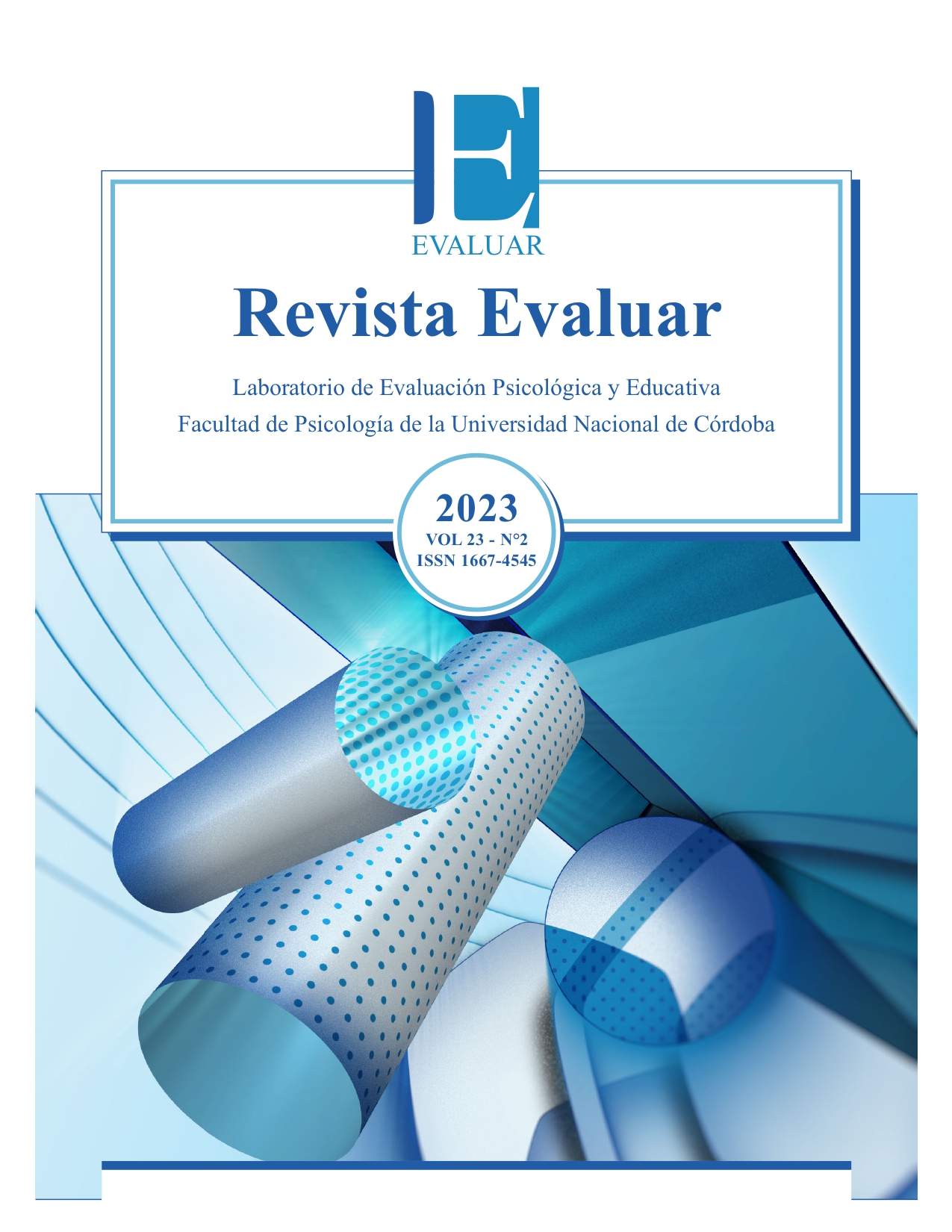Suicidal Behavior at Work Scales: Development and Validation of the Work-Related Suicidal Ideation, Defeat, and Entrapment Brief Scales
DOI:
https://doi.org/10.35670/1667-4545.v23.n2.42064Keywords:
CFA, EFA, Defeat, Entrapment, Measurement Invariance, Suicidal Ideation, Work-Related Suicidal IdeationAbstract
Suicide is a health problem around the world, since suicide rates among Americans aged 45 to 54 is the highest, and most of these individuals were employed at the time of their death. Thus, there is a need to better understand suicidal behavior at work by developing appropriate measurement instruments in order to create prevention and treatment programs. Therefore, the aim of this study was to develop and validate three brief self-report measures of suicidal behavior at work: defeat, entrapment, and work-related suicidal ideation. A total of 1,829 employed individuals from different organizations in Puerto Rico participated in this cross-sectional research design. We conducted item, exploratory, and confirmatory factor analyses. Also, we tested measurement invariance of the new brief scales of suicidal behavior at work. The final version of the suicidal behavior at work brief scales obtained excellent reliability coefficients using Cronbach’s alpha and McDonald’s omega techniques. The results of the EFA and CFA support their internal structure. The new scale appears to be invariant among groups. The scores of the new suicidal behavior at work brief scales appear to be reliable, valid, and invariant, which will help to study and to better understand these behaviors in order to create treatments and prevention programs in our workplaces.
Downloads
References
Avendaño-Prieto, B. L., Pérez-Prada, M., Vianchá-Pinzón, M., Martínez-Baquero, L., & Toro, R. (2018). Propiedades psicométricas del inventario de ideación suicida positiva y negativa PANSI. Revista Evaluar, 18(1). https://doi.org/10.35670/1667-4545.v18.n1.19767
Browne, M. W., & Cudeck, R. (1993). Alternative ways of assessing model fit. In K. A. Bollen & J. S. Long (Eds.), Testing structural equation models (pp. 136-162). SAGE.
Byrne, B. M. (2016). Structural equation modeling with AMOS: Basic concepts, applications, and programming (3rd ed.). Routledge. https://doi.org/10.4324/9781315757421
Caputo, A. (2017). Social desirability bias in self-reported well-being measures: Evidence from an online survey. Universitas Psychologica, 16(2). https://doi.org/10.11144/Javeriana.upsy16-2.sdsw
Chen, F. F. (2007). Sensitivity of goodness of fit indexes to lack of measurement invariance. Structural Equation Modeling, 14(3), 464-504. https://doi.org/10.1080/10705510701301834
Cohen, J. (1988). Statistical power analysis for the behavioral sciences (2nd ed.). Routledge Academic. https://doi.org/10.4324/9780203771587
Commission for the Prevention of Suicide. (2016). Estadísticas preliminaries de casos de suicidio Puerto Rico, enero – diciembre 2016. Estado Libre Asociado de Puerto Rico, Departamento de Salud. https://www.dropbox.com/s/va6cwyh84ajamu6/Estadisticas%20Suicidios%20en%20Puerto%20Rico%20Diciembre%202016.pdf?dl=0
Cropley, M., Michalianou, G., Pravettoni, G., & Millward, L. J. (2012). The relation of post-work ruminative thinking with eating behaviour. Stress & Health, 28(1), 23-30. https://doi.org/10.1002/smi.1397
Curns, D. B. (2014). A validity study of the Reasons for Life Scale with emerging adult college students. Unpublished dissertation for University of Alaska Fairbanks and Anchorage. https://scholarworks.alaska.edu
DeVellis, R. F. (2017). Scale development: Theory and applications (4th ed.). SAGE.
Fabrigar, L. R., Wegener, D. T., MacCallum, R. C., & Strahan, E. J. (1999). Evaluating the Use of Exploratory Factor Analysis in Psychological Research. Psychological Methods, 4, 272-299. https://doi.org/10.1037/1082-989X.4.3.272
Fornell, C., & Bookstein, F. L. (1982). Two structural equation models: LISREL and PLS applied to consumer exit-voice theory. Journal of Marketing Research, 19(4), 440-452. https://doi.org/10.2307/3151718
Fornell, C., & Larcker, D. F. (1981). Evaluating structural equation models with unobservable variables and measurement error. Journal of Marketing Research, 18(1), 39-50. https://doi.org/10.2307/3151312
Hair, J. F., Black, W. C., Babin, B. J., & Anderson, R. E. (2019). Multivariate data analysis (8th ed.). Cengage Learning EMEA.
Hayes, A. F., & Coutts, J. J. (2020). Use Omega rather than Cronbach’s Alpha for estimating reliability. But… Communication Methods and Measures, 14(1), 1-24. https://doi.org/10.1080/19312458.2020.1718629
Hu, L.-T., & Bentler, P. M. (1995). Evaluating model fit. In R. H. Hoyle (Ed.), Structural equation modeling: Concepts, issues, and applications (pp. 76-99). SAGE.
Hu, L.-T., & Bentler, P. M. (1999). Cutoff criteria for fit indexes in covariance structure analysis: Conventional criteria versus new alternatives. Structural Equation Modeling, 6(1), 1-55. https:// doi.org/10.1080/10705519909540118
IBM Corp. (2021). IBM SPSS Statistics for Windows, Version 28.0. Armonk, NY: IBM Corp.
Kasl, S. V., & Jones, B. A. (2003). An epidemiological perspective on research design, measurement, and surveillance strategies. In J. Campbell Quick & L. E. Tetrick (Eds.), Handbook of Occupational Health Psychology (pp. 377-398). American Psychological Association.
Kline, P. (1994). An easy guide to factor analysis (1st ed.). Routledge.
Kline, R. B. (2016). Principles and practice of structural equation modelling (4th ed.). The Guilford Press.
Klonsky, E. D., Saffer, B. Y., & Bryan, C. J. (2018). Ideation-to-action theories of suicide: A conceptual and empirical update. Current Opinion in Psychology, 22, 38-43. https://doi.org/10.1016/j.copsyc.2017.07.020
Kroenke, K., Spitzer, R. L., & Williams, J. B. W. (2001). The PHQ-9: Validity of a brief depression severity measure. Journal of General Internal Medicine, 16(9), 606-613. https://doi.org/10.1046/j.1525-1497.2001.016009606.x
Li, C.-H. (2016a). Confirmatory factor analysis with ordinal data: Comparing robust maximum likelihood and diagonally weighted least squares. Behavior Research Methods, 48(3), 936-949. https://doi.org/10.3758/s13428-015-0619-7
Li, C.-H. (2016b). The performance of ML, DWLS, and ULS estimation with robust corrections in structural equation models with ordinal variables. Psychological Methods, 21(3), 369-387. https://doi.org/10.1037/met0000093
Littlewood-Zimmerman, H. F., & Bernal-García, E. R. (2011). Mi primer modelamiento de ecuación estructural: LISREL. Centro de Investigación en Comportamiento Organizacional (CINCEL).
MacCallum, R. C., Browne, M. W., & Sugawara, H. M. (1996). Power analysis and determination of sample size for covariance structure modeling. Psychological Methods, 1(2), 130-149. https://psycnet.apa.org/doi/10.1037/1082-989X.1.2.130
Marsh, H. W., Balla, J. R., & Hau, K. T. (1996). An evaluation of incremental fit indexes: A clarification of mathematical and empirical properties. In G. A. Marcoulides & R. E. Schumacker (Eds.), Advanced structural equation modeling techniques (pp. 315-353). Lawrence Erlbaum.
Mortali, M. G., & Moutier, C. (2019). Suicide prevention in the workplace. In M. B. Riba, S. V. Parikh & J. F. Greden (Eds.), Mental health in the workplace: Strategies and tools to optimize outcomes. Springer.
Muthén, L. K., & Muthén, B. O. (2012). Mplus User’s Guide: Statistical Analysis with Latent Variables (7th ed.). Muthén & Muthén.
O’Connor, R. C. (2011). Towards an integrated motivational-volitional of suicidal behavior. In R. C. O’Connor, S. Platt & J. Gordon (Eds.), International handbook of suicide prevention: Research, policy and practice (pp. 181-198). Wiley-Blackwell.
O’Connor, R. C., Cleare, S., Eschle, S., Wetherall, K., & Kirtley, O. J. (2016). The integrated motivational-volitional model of suicidal behavior: Update. In R. C. O’Connor & J. Pirkis (Eds.), The International Handbook of Suicide Prevention (pp. 220-240). John Wiley & Sons.
O’Connor, R. C., & Nock, M. K. (2014). The psychology of suicidal behaviour. The Lancet Psychiatry, 1(1), 73-85. https://doi.org/10.1016/S2215-0366(14)70222-6
Otsuka, Y., Nakata, A., Sakurai, K., & Kawahito, J. (2016). Association of suicidal ideation with job demands and job resources: A large cross-sectional study of Japanese workers. International Journal of Behavioral Medicine, 23(4), 418-426. https://doi.org/10.1007/s12529-016-9534-2
Peterson, C., Stone, D. M., Marsh, S. M., Schumacher, P. K., Tiesman, H. M., McIntosh, W. L.-K., Lokey, C. N., Trudeau, A.-R.T., Bartholow, B., & Luo, F. (2018). Suicides rate by major occupational group–17 states, 2012 and 2015. Morbidity and Mortality Weekly Report, 67(45), 1253-1260. http://dx.doi.org/10.15585/mmwr.mm6745a1
Ponterotto, J. G., & Ruckdeschel, D. E. (2007). An overview of Coefficient Alpha and a reliability matrix for estimating adequacy of internal consistency coefficients with psychological research measures. Perceptual and Motor Skills, 105(3), 997-1014. https://doi.org/10.2466/pms.105.3.997-1014
Rigdon, E. E. (1995). A necessary and sufficient identification rule for structural models estimated in practice. Multivariate Behavioral Research, 30(3), 359-383. https://doi.org/10.1207/s15327906mbr3003_4
Rosario-Hernández, E., & Rovira-Millán, L. V. (2002). Desarrollo y validación de una escala para medir actitudes hacia el retiro. Revista Puertorriqueña de Psicología, 13, 45-60. https://www.repsasppr.net/index.php/reps/index
Rosario-Hernández, E., Rovira-Millán, L. V., & Merino-Soto, C. (2021). Review of the internal structure, psychometric properties, and measurement invariance of the Work-Related Rumination Scale –Spanish Version. Frontiers in Psychology, 12. https://doi.org/10.3389/fpsyg.2021.774472
Rosario-Hernández, E., Rovira-Millán, L. V., Vega-Vélez, S., Zeno-Santi, R., Farinacci-García, P., Centeno-Quintana, L., Navedo-Santos, J., Feliciano-Toro, B. P., De Jesús-Caraballo, R., Morell-Fausto, J., Cepeda-Fax, S., Cintrón-Lugo, M., Colón-Burgos, L., Sánchez-Ortiz, N., Sánchez-Collazo, I., Díaz-Pla, L., Toledo-Medina, M. A., Flores-Quirós, A. S., & Pagán-Torres, O. M. (2019). Exposure to workplace bullying and suicidal ideation: An exploratory study. Journal of Applied Structural Equation Modeling, 3(1), 55-75. https://doi.org/10.47263/JASEM.3(1)06
Rosseel, Y. (2012). lavaan: An R package for structural equation modeling. Journal of Statistical Software, 48(2), 1-36. https://doi.org/10.18637/jss.v048.i02
Spector, P. E. (1992). Summated rating scale construction: An introduction. SAGE.
Spitzer, R. L., Kroenke, K., Williams, J. B. W., & Löwe, B. (2006). A brief measure for assessing generalized anxiety disorder. Tthe GAD-7. Archives of Internal Medicine, 166(10), 1092-1097. https://doi.org/10.1001/archinte.166.10.1092
Stark, S., Chernyshenko, O. S., & Drasgow, F. (2006). Detecting differential item functioning with confirmatory factor analysis and item response theory: Toward a unified strategy. Journal of Applied Psychology, 91(6), 1292-1306. https://doi.org/10.1037/0021-9010.91.6.1292
Suominen, K., Isometsä, E., Ostamo, A., & Lönnqvist, J. (2004). Level of suicidal intent predicts overall mortality and suicide after attempted suicide: A 12-year follow-up study. BMC Psychiatry, 4, Article 11. https://doi.org/10.1186/1471-244X-4-11
Tang, N. K. Y., Goodchild, C. E., Hester, J., & Salkovskis, P. M. (2010). Mental defeat is linked to interference, distress and disability in chronic pain. Pain, 149(3), 547-554. https://doi.org/10.1016/j.pain.2010.03.028
Taylor, P. J., Gooding, P. A., Wood, A. M., Johnson, J., Pratt, D., & Tarrier, N. (2010). Defeat and entrapment in schizophrenia: The relationship with suicidal ideation and positive psychotic symptoms. Psychiatry Research, 178(2), 244-248. https://doi.org/10.1016/j.psychres.2009.10.015
Taylor, P. J., Wood, A. M., Gooding, P., & Tarrier, N. (2010). Appraisals and suicidality: The mediating role of defeat and entrapment. Archives of Suicide Research, 14(3), 236-247. https://doi.org/10.1080/13811118.2010.494138
Taylor, P. J., Wood, A. M., Gooding, P., Johnson, J., & Tarrier, N. (2009). Are defeat and entrapment best defined as a single construct? Personality and Individual Differences, 47(7), 795-797. https://doi.org/10.1016/j.paid.2009.06.011
Teismann, T., & Forkmann, T. (2017). Rumination, entrapment and suicide ideation: A mediational model. Clinical Psychology & Psychotherapy, 24(1), 226-234. https://doi.org/10.1002/cpp.1999
Tiesman, H. M., Konda, S., Hartley, D., Chaumont-Menéndez, C., Ridenour, M., & Hendricks, S. (2015). Suicide in U.S. workplaces, 2003-2010: A comparison with non-workplace suicides. American Journal of Preventive Medicine, 48(6), 674-682. https://doi.org/10.1016/j.amepre.2014.12.011
Treynor, W., Gonzalez, R., & Nolen-Hoeksema, S. (2003). Rumination reconsidered: A psychometric analysis. Cognitive Therapy and Research, 27(3), 247-259. https://doi.org/10.1023/A:1023910315561
Tucker, L. R., & Lewis, C. (1973). A reliability coefficient for maximum likelihood factor analysis. Psychometrika, 38(1), 1-10. https://doi.org/10.1007/BF02291170
Vecco, G. A., Flores-Kanter, P. E., & Luque, L. E. (2021). Análisis psicométrico del Inventario de Orientación Suicida ISO-19, en adolescentes cordobeses escolarizados. Revista Evaluar, 21(1), 39-52. https://doi.org/10.35670/1667-4545.v21.n1.32831
Wang, J., & Wang, X. (2012). Structural equation modeling: Applications using Mplus (1st ed.). John Wiley & Sons.
World Health Organization. (2021). Suicides worldwide in 2019: Global health estimates. https://www.who.int/publications
Downloads
Published
How to Cite
Issue
Section
License

This work is licensed under a Creative Commons Attribution 4.0 International License.
Revista Evaluar aplica la Licencia Internacional de Atribuciones Comunes Creativas (Creative Commons Attribution License, CCAL). Bajo esta licencia, los autores retienen la propiedad de copyright de los artículos pero permiten que, sin que medie permiso de autor o editor, cualquier persona descargue y distribuya los artículos publicados en Evaluar. La única condición es que siempre y en todos los casos se cite a los autores y a la fuente original de publicación (i.e. Evaluar). El envío de artículos a Evaluar y la lectura de los mismos es totalmente gratuito.




_(3).jpg)



.jpg)



